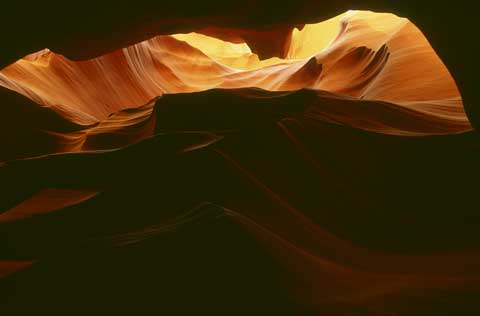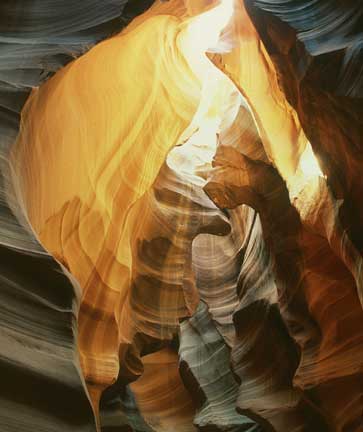This subject is featured in the The Luminous Landscape Video Journal.
One of the icons of contemporary landscape photography is Antelope Canyon near Page, Arizona. These so-called slot canyons are a unique geological formation. Access to the canyons is now restricted by the Navajo (whose land it’s on), in large measure due to a flash flood in 1997 which killed more than a dozen tourists and photographers.
Antelope Canyon #3, Arizona,1998
Because of the great depth and narrowness of the canyon there is only one time when the light is magical, or even allows any sort of photography—mid-day. Butaround local noon, for a couple of hours, Antelope Canyon is like no other place on earth.
Be prepared to spend the better part of the day though as your guide (found in the town of Page) will take you out to the canyons at about 10am and not pick you up again until several hours later.
Antelope Canyon #2, Arizona,1998
This is one of the world’s most remarkable locations for photography. It is not an easy place to work. Because access is in groups you’ll find yourself tripping over other photographer’s tripods in an effort to find just the right angle for a shot.
Many images from Antelope fail to provide a sense of scale. This photograph, with its ghostly people — due to a several second exposure — captures some of the awe-inspiring grandeur of this very special place.
Antelope Canyon #1 — Arizona, 1998
The other major issue when shooting in Antelope is sand. The slot canyon is very narrow, and at the top lies a field of fine sand which is constantly being blown downward. It’s like a light drizzle of rain, but much more damaging to your cameras and lenses. I had been forewarned and kept my camera and tripod, as well as equipment bag, covered with large plastic garbage bags except when actually shooting. Even so, sand got into everything and required exhaustive cleaning for days afterward.
The canyon, which is 80-100 feet deep is actually that deep again in sand beneath ones feet. Only when there is an occasional flash-flood is some of the sand washed away. Without these floods the canyon would become completely filled to the top with sand and would effectively disappear.
Antelope Bush, Arizona, 1998
The light in Antelope Canyon is constantly changing. My first close exposure to Antelope was a fascinating black & white photograph which I purchased in the early ’90s by a photographer named David Cary. It hung in my home and haunted me for several years until I finally visited Antelope in ’98. I was prepared for the wonder of the geological formations but not for the richness of the colour. This photograph comes as close as I’ve yet done to capturing just the form of the place rather than having the image overpowered by colour.
Antelope 4, Arizona, 1998
The shapes are sensuous and sometimes confusing. With more than a year between the shooting and the printing of this picture I have no recollection of what the orientation was when I shot it. But I love the textures and shapes.
Antelope 5, Arizona, 1998
The greatest challenge to photography at Antelope Canyon is exposure, or at least the incredible dynamic range that the photographer is faced with. It seems that the choice is either blown-out highlights or blocked-up shadows. The safest bet, as always when shooting narrow latitude colour transparency film is to expose for the highlights and let the shadows fall where they may.
One of the reasons that it has taken over a year to get these images on-line is that it was only recently that I had a scanner (Imacon FlexTight Photo) capable of capturing the broad dynamic range contained in these medium format transparencies.
Antelope 6, Arizona, 1998
When printing images taken at Antelope Canyon it’s important to resist the temptation to exaggerate the colours. They are so intense that in fact I have tried to err on the side of desaturating and keeping the non-sunlight areas as neutral as possible.
Antelope 7, Arizona, 1998
Many of the images of Antelope Canyon that I’ve seen over the years have had the quality of optical illusions due to the alternating areas of light and dark combined with the lack of perspective. This photograph has some of those qualities, particularly when seen at a large size.
All photographs on this page were taken with a Rollei 6008 and Schneider 40mm and 90mm lenses on Provia 100.
![]() This subject will be featured in a forthcoming issue of The Luminous Landscape Video Journal.
This subject will be featured in a forthcoming issue of The Luminous Landscape Video Journal.
updated August 2016
You May Also Enjoy...
Kevin and Michael’s Toy Shop
Michael and I are both recovering camera gear addicts. We also receive a great deal of equipment for review. We are always looking at what







